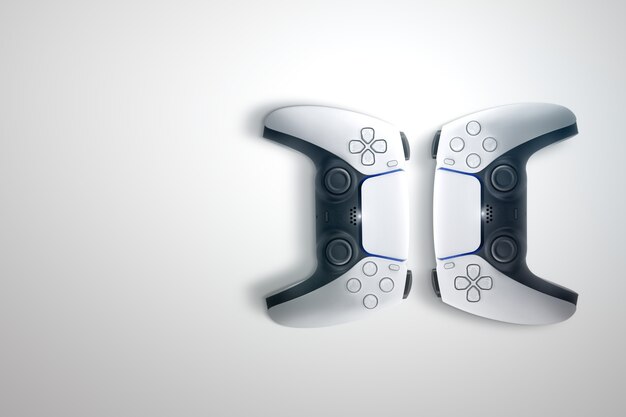Haptic Feedback & Adaptive Triggers: Next-Gen Console Gameplay

New controller tech, specifically haptic feedback and adaptive triggers, is revolutionizing console gameplay by offering deeper immersion and more realistic interactions within the virtual world.
Console gaming is constantly evolving, and recent innovations in controller technology are taking the experience to new heights. New controller tech: How haptic feedback and adaptive triggers are changing console gameplay by adding layers of realism that were previously unimaginable, transforming how players connect with the games they love.
Understanding Haptic Feedback: A New Sense of Touch
Haptic feedback goes beyond basic rumble. It’s a sophisticated system that approximates the sensation of touch, providing nuanced and contextual vibrations that represent in-game textures, impacts, and environments.
This technology creates a deeper sense of immersion by engaging your sense of touch, making interactions feel more real: the clatter of footsteps on cobblestone, the satisfying *thunk* of a weapon reload, or the gentle tug of a bowstring are all conveyed through haptic vibrations.
How Haptic Feedback Works
Instead of relying on a single, spinning motor to create vibration, haptic controllers employ complex actuators capable of producing a far wider range of precise and nuanced sensations. These actuators can simulate a variety of tactile sensations, from gentle raindrops to powerful explosions.
Benefits of Haptic Feedback
Improved immersion is just one of the advantages. Haptic feedback can also provide invaluable feedback to the player, enhancing gameplay in numerous creative ways.
- Enhanced Immersion: Feel the game world in your hands, making interactions more believable.
- Improved Awareness: Receive subtle cues about in-game events through tactile sensations.
- Greater Realism: Experience textures, impacts, and environmental effects with unprecedented fidelity.
- Increased Engagement: Become more absorbed in the game world by having another sense engaged.
Haptic feedback is blurring the line between virtual and real. Because of the precision and depth of this technology, the player feels a greater sense of presence and connection to the world of the game.
Adaptive Triggers: Feeling the Tension
Adaptive triggers bring a new level of control and realism to games. Unlike traditional buttons, these triggers can dynamically adjust the amount of resistance they provide based on in-game actions, simulating the feel of real-world objects and actions.
The experience is very realistic in games that support this feature. Adaptive triggers create a tactile connection to the game world whenever they are pulled. Players can feel the weight of a car accelerating, the tightness of a bowstring, or even the feedback from firing an automatic weapon.
How Adaptive Triggers Work
Adaptive triggers are equipped with motorized mechanisms that control the amount of force you have to exert to pull them. Game developers can use this mechanism adjust the trigger’s resistance according to what’s happening in the game.

Benefits of Adaptive Triggers
Adaptive Triggers add a tangible layer to the gameplay experience that was never available before.
- Greater Control: Precisely modulate your inputs within the game based on the amount of resistance felt.
- Enhanced Realism: Feel the unique physical actions of in-game, like firing a weapon or driving a car.
- Increased Immersion: Experience a heightened sense of involvement in the game world.
- Tactile Feedback: Receive immediate feedback through the triggers, making actions feel more meaningful.
All of these enhance gameplay, making it possible to engage the environment much more intimately. Adaptive triggers translate on-screen actions into the feel of your hands.
The Impact on Game Design
Haptic feedback and adaptive triggers are affecting how games are being designed. Developers now have new tools at their disposal for conveying sensations and realistic feedback.
These new technologies allow for the creation of richer, more immersive experiences with gameplay that is more strategic and thoughtful. This gives game developers a wider range of options for making the games more appealing and challenging.
New Approaches to Immersion
Developers are using haptic feedback to create dynamic virtual worlds, with the feeling of rain, different surfaces, and in-game vibrations can be felt in the controller. They are also using adaptive triggers to create new challenges and tactical depth.
Creating New Gameplay Mechanics
These controller technologies can affect the control scheme, and the immersion can be dramatically increased.
- Tactile Cues: Using haptic feedback to tell a story.
- Realistic Resistance: Adaptive triggers also enhance combat realism.
- Environmental Feedback: Feel every bump on the road through haptic feedback.
With the addition of these features, the games can respond back to the player
Popular Games Utilizing Haptic and Adaptive Features
A growing number of titles are taking full advantage of haptic feedback and adaptive triggers, demonstrating the potential of these features to transform gameplay. Here are some notable examples:
Games that use these technologies deliver uniquely immersive experiences and show the power of controller technology to augment gaming.
Demon’s Souls
**Demon’s Souls** uses every detail when crafting the environments on your travels. This ranges from impacts to the scraping sounds on metal. This all comes to life in your hand.
Astro’s Playroom
**Astro’s Playroom** is a celebration of PlayStation history, specifically designed to showcase the capabilities of the DualSense controller. Every texture, interaction, and event is brought to life through intricate haptic feedback, making it a tactile joy to explore. Adaptive triggers simulate the feeling of pulling levers, gliding on ice, and other interactions.

Other Noteworthy Titles
Other games continue to use and create new ways to take advantage of these technologies, which are becoming more popular every day.
These innovations show that the controller is not just a device to control, but also to feel. This is only just the beginning.
The Future of Controller Technology
Haptic feedback and adaptive triggers are only the beginning. Game controllers of the future promise even greater levels of immersion, realism, and customization. These improvements will enhance gameplay, making it even more engaging for all involved.
We can expect to see advancements that will continue to push the boundaries of what is possible in console gaming. Improved immersion will be the norm.
Potential Improvements
The technology available for controllers has not plateaued. The field is still expanding, and things are becoming possible that weren’t before. Haptic feedback and adaptive triggers are just the beginning.
- Advanced Actuators: Future controllers may employ more advanced actuators capable of producing even wider range of tactile sensations.
- AI-Driven Haptics: Artificial intelligence is revolutionizing virtually every industry.
- Biometric Integration: Incorporate sensors that can detect heart rate, skin conductance, and other biometric data.
Improvements to controllers will make the experience of playing video games all the more intense, and realistic.
How to Experience Haptic Feedback and Adaptive Triggers
Experiencing the full potential of haptic feedback and adaptive triggers requires compatible hardware and software. Here’s what you need to immerse yourself in the tactile revolution.
To take advantage of these technologies one needs to be aware of all the equipment and features required to properly use them.
Hardware Considerations
Right now, certain consoles are more compatible with these technologies than others- for example, **Sony’s Playstation 5** console supports haptic feedback and adaptive triggers on its Dualsense controller.
Software Requirements
With the equipment being able to handle the technology, it’s important that the game has the available options for the controller to utilize.
- Game Compatibility: Not every game supports haptic feedback and adaptive triggers. Check compatibility on the game.
- Settings Configuration: Most games with these features allow you to customize the intensity.
By ensuring you have the right hardware and adjusting the software, you can have an gaming experience that is more immersive than ever before.
| Key Point | Brief Description |
|---|---|
| 🎮 Haptic Feedback | Simulates touch sensations for enhanced immersion. |
| 🕹️ Adaptive Triggers | Adjust resistance dynamically for realistic interactions. |
| ✨ Game Design | Enables richer, more immersive gameplay experiences. |
| 🔊 Compatibility | Requires compatible hardware and software for it to function. |
Frequently Asked Questions
▼
Haptic feedback simulates touch sensations by using vibrations and textures in the controller. This provides a more immersive and realistic gaming experience.
▼
Adaptive triggers dynamically adjust the trigger’s resistance, which simulates real-world actions like pulling back a bowstring so that each action will feel more meaningful.
▼
Titles such as “Demon’s Souls” and “Astro’s Playroom” are known for implementing haptic feedback and adaptive triggers. The technology has also been utilized in other sports related games.
▼
It provides better awareness and immersion. Realism increases due to the improved interactions based on effects from the environment and textures that would feel very real.
▼
Yes, intensity can be customized based on the game’s settings. There are a range of customization settings that will assist in getting the desired experience and maximizing the immersion.
Conclusion
Haptic feedback and adaptive triggers represent a major leap forward in console gaming, transforming the way players interact with and experience virtual worlds. As more developers embrace these technologies, we can expect future of game design to become more profound with each controller improvement.





